

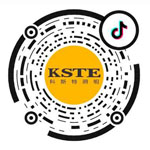
1、Light
Light is an electromagnetic wave。
Visible light: part of the radiant energy emitted by the light source, that is, the radiant energy that can produce vision. It is often called "visible light".
Wavelength of visible light: from 380nm to 780nm
Wavelength of ultraviolet ray: from 100nm to 380nm, invisible to the naked eye.
Wavelength of infrared ray: 780nm -- 1mm, invisible to the naked eye.
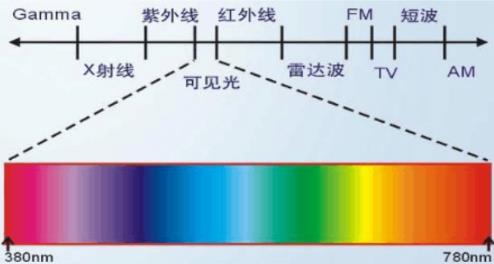

2、Color temperature
It is expressed in absolute temperature K. It refers to heating a standard black body, and when the temperature rises to a certain degree, the color starts to change from red light red orange yellow white blue white, and gradually changes. With the characteristics of light color change, when the light color of a light source is the same as that of a black body at a certain temperature, we call the absolute temperature of the black body at that time the phase of the light source关色温。
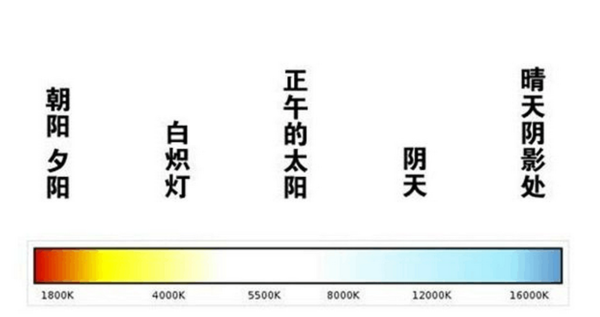
3、Color rendering index (Ra)
A parameter that measures the ability of the light source to show the true color of the object being illuminated.
The higher the color rendering index (0-100), the closer the color reproduction of the light source to the natural primary color.


3.1、Color temperature and feeling
色 温 | 光 色 | 气氛效果 | 光 源 |
大于6500K | 清凉(带蓝的白) | 清冷的感觉 | 荧光灯、水银灯 |
3300-6500K | 中间(接近自然光) | 无明显心理效果 | 荧光灯、金卤灯 |
小于3300K | 温暖(带桔黄的白) | 温暖的感觉 | 白炽灯、卤素灯杯 |
3.2、Color Temperature and Sensation Human Biological Clock and Light Color Temperature

3.3、Effect and use of color rendering
Ra | 感觉 | 用途 |
>90 | 极好 | 对色彩鉴别要求极高的场所,如印刷、印染品检验等 |
80-90 | 很好 | 彩色电视转播、陈列的展品照明 |
65-80 | 较好 | 室内照明 |
50-65 | 中等 | 室外照明 |
<50 | 较差 | 对色彩要求不高的场所,如停车场、货场等 |
4. Luminous flux (lumen Lm)
It indicates how much the illuminant emits light. Lumen is the unit of luminous flux. (The more luminous, the greater the lumen number)
5. Photoefficiency
The ratio of luminous flux produced by the light source to the electric power consumed. Unit: Lumens/Watt (Lm/W)
6. Average life
Also known as rated life, it refers to the number of hours when a batch of lamps are lit up to half of the number and are damaged.
7. Light intensity
Luminous flux in unit solid angle Unit: cd
8. Illuminance
Illuminance is used to describe the degree of exposure on the illuminated surface (working surface), which is usually expressed by the luminous flux received in unit area, and the unit is lux (lx) or lumen per square meter (lm/m2).
9. Brightness
Luminance is a physical quantity used to indicate the brightness (or reflection) of the object surface. The ratio of the luminous intensity of the viewed object's luminous surface in the line of sight direction to the projected area of the luminous surface in the direction perpendicular to that direction is called the surface brightness of the luminous surface, and the unit is candela per square meter (cd/m2).
10. Luminous efficiency
It is commonly referred to as luminous efficiency, which is an optical quantity that describes the quality and economy of the light source. It reflects the amount of luminous flux radiated by the light source while consuming unit energy, and the unit is lumen per watt (lm/w)
11. Beam angle
It refers to the angle of light of the lamp and the angle of the lamp cup. Generally, there are 3 kinds, 10 °, 24 ° and 38 °.The following figure shows the effect of three lamp cups with the same power but different beam angles on the wall, and the schematic diagram of the light distribution curve of the three beam angles. The larger the beam angle of a lamp cup with the same power, the smaller the central light intensity, the wider and softer the light spot, the smaller the phase reflection beam angle, the greater the central light intensity, and the narrower and stiffer the light spot.
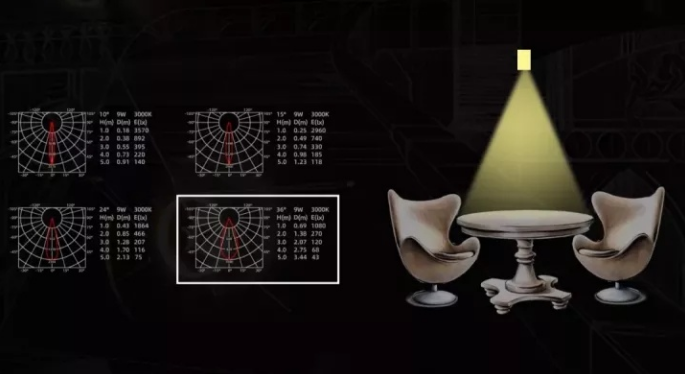
Effects of different beam angles

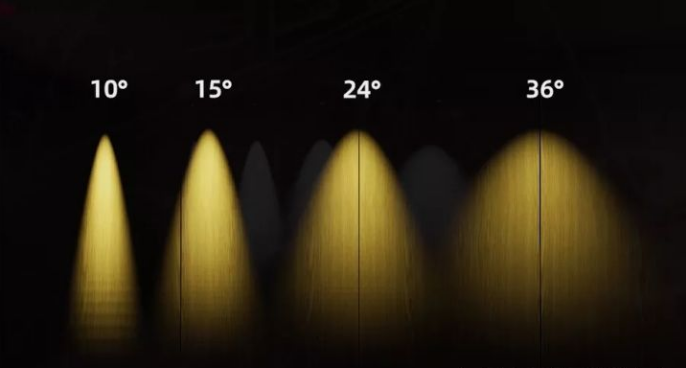
12、Color appearance and illumination
The color rendering index of the light source together with the illuminance determines the visual clarity of the environment. There is a balance between illuminance and color rendering index. The result obtained from extensive experiments is that the illumination value of an office illuminated by a lamp with a color rendering index Ra>90 is 25% higher than that of an office illuminated by a lamp with a low color rendering index (Ra<60) in terms of its appearance satisfaction.
It should be noted that for a good visual appearance, it is not feasible to reduce the indoor illumination to a level that deteriorates the visual function in order to save energy. The light source with the best color rendering index and high luminous efficiency shall be selected as far as possible, and the appropriate illuminance shall be used to obtain a good visual appearance with the minimum energy cost.
显色类别 | 一般显色指数范围 | 适用场所举例 | |
Ⅰ | A | Ra≥90 | 颜色匹配、颜色检验等 |
B | 90>Ra≥80 | 印刷、食品分检、油漆、店铺、饭店等 | |
Ⅱ | 80>Ra≥60 | 机电装配、表面处理、控制室、办公室、百货等 | |
Ⅲ | 60>Ra≥40 | 机械加工、热处理、铸造等 | |
40>Ra≥20 | 仓库、大件金属库等 | ||
13、Relationship between color temperature and illumination level


14、Light environment
Light environment is people's psychological feeling of light in a certain visual space.
A good light environment gives people a good visual experience, which directly affects people's physical and mental health.
People should consider energy conservation while considering creating a good light environment. The concept of green lighting is how to reduce the release of mercury and how to save the limited energy that human beings have to survive